Greater Exodus Prep- Practical Shelters

image courtesy of freebibleimages.org
This post is the first in a series we will be doing, with fellow Hebrews in mind. Those of us awaiting the "Greater Exodus" together, when Yah (God) gathers ALL the tribes and brings them all back to the land, together.
It is mentioned in several places in scripture (Jeremiah, Ezekial, Isaiah & Revelation) .
The purpose of this post is not to do a bible study on this topic though, as many have already done so. We will put a link to a few below.
Our purpose in this series of posts is to start discussing practical prepping ideas for this great event.
Yes, we know we 'practice' for living among one another every year at Sukkot BUT do we practice and truly prepare for the real deal?
Today, we will be looking at various shelters and perhaps we may bring up some things you hadn't thought of (or maybe you have) or ideas on shelters you'd never considered before.
Let's get prepping!
Keeping it Mobile
The first thing we should discuss is the fact that this event will be a journey. Yah only knows if we will have to ability to utilize vehicles and it's pretty obvious we won't necessarily be able to use cars/trucks everywhere in a "wilderness", nor would everyone have an ATV or livestock to help either. SO...with that being said, we should probably try to keep things as light and practical as possible.
For a shelter, it would only make sense that we would want it to be very durable, portable, as lightweight as possible and as versatile as possible.
Considerations
Things to consider, in light of all mentioned above:
I know it isn't part of the mobility or overall function but it may be one of the biggest considerations for folks. I know it was for us....PRICE! Is it reasonable for what you are getting, even for the average Joe?
What is the weight of your shelter? Is it easily carried or are you going to have to have something special to carry it for you?
Does it pack down small or take up a lot of space?
How big is your shelter when it's completely set up?- Is it able to be put up in smaller spaces as well as larger areas?
Will it fit your family comfortably, with your gear, or will it barely accommodate you for a short period of time; much less a longer term?
Is your shelter designed for more than one or two seasons?
How durable is it? Does it damage easily and will it hold up under tougher climate conditions like high winds, high heat, lots of rain or snow?
Does it take specialized equipment that you can only get certain places?
Finally....is it SIMPLE & QUICK? Does it take a booklet of instructions to set up or is it simple and quick enough even your 5yr old could help out and have it set up in short order?
It sounds like a lot, doesn't it? They are important things to look for though, for this particular journey. It's not like any other camping trip and we don't want to be caught out in the wilderness ill-prepared. We want to be able to care for ourselves as well as help others.
Okay... Now that we know what our considerations are, let's look for some that fit the bill.
Note: while we mention some specific brands/manufacturers here, these are not the only ones we'd consider. There are many more out there with the same or similar qualities. These are for example purposes only.
Backpacking/Mountaineering Shelters
The best place to look for lightweight shelters are those who design and cater to mountaineering/ backpacking. They are meant to be as light as they can get, where every ounce counts. Tough, durable material matters bc high winds, snow, ice etc will be the norm on a mountain top. Not all will be large enough to house a family though, unless designed for a base camp or hunting scenario. So, let's take a look at a few out there.
Kifaru
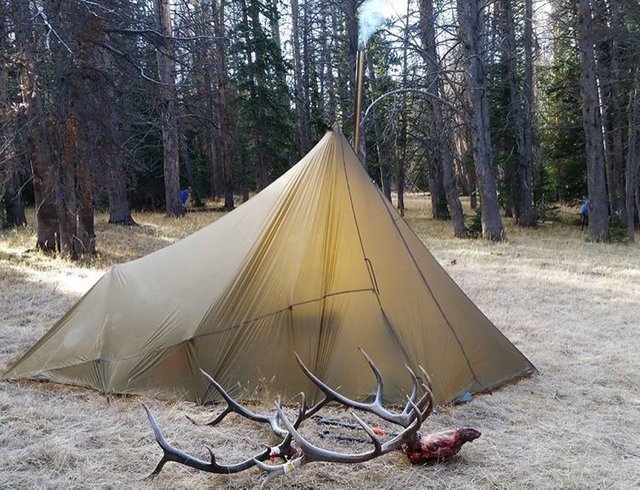
(https://store.kifaru.net/shelters-c5.aspx) - one of the best known for backpacking/mountaineering tents. They make a very lightweight product line. This particular tent shown is a 4-man or a 2-man with a stove and weighs in at a whopping 4.5lbs with the stakes & pole included. Their tents range in size from 2-man tents up to 24-man tents. The downside to Kifaru is their price and that their tents need carbon poles.Seek Outside
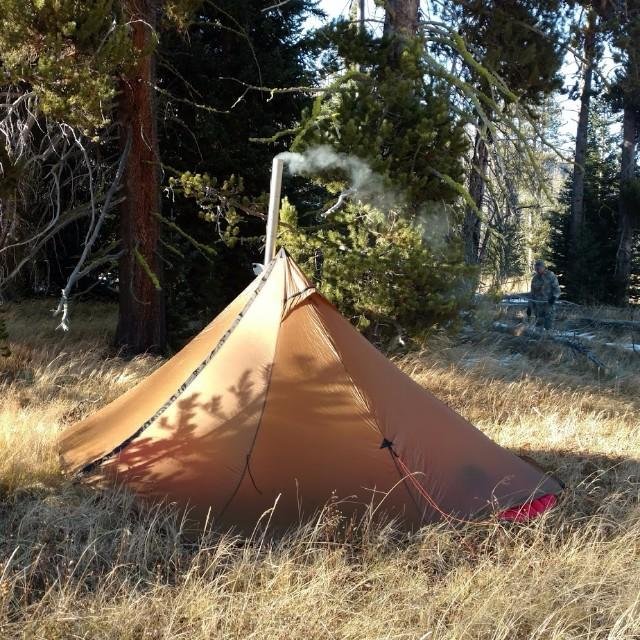
https://seekoutside.com/tipi-tents/
Seek Outside also makes an excellent product (of which we have personally tried), that is lightweight (even less than Kifaru),designed for backcountry backpackers/mountaineering. This particular tent shown is their Cimarron, which is also a 4-man or 2-man with stove. This particular one weighs in, with the carbon pole and stakes, at 3.5lbs. Their tents also range from 1-man up to 24-man tents.
Pros/Cons:
Pros
Both companies make an extremely lightweight product.
Neither have a need to be folded down and pack very small. Our Seek one, was bigger than these two above and packed down to just about fanny pack size.
Both are designed to withstand very high winds, rain and snow loads, having extra guy out point that other shelters may not have.
Both have multiple shelters (usually the tipis) that have the ability to be made into a double-wall shelter, utilizing a liner (adding minimal weight), to prevent condensation from getting on you and ventilating better.
Both have the ability to utilize a 'nests' (inner tents) or half floors, to keep out bugs, if you so desire.
Both companies provide 4-season shelters, having the ability to utilize a stove in them,via a stove jack, for heat/cooking.
Seek Outside shelters have been customized to have reinforced pole pockets, for using dead fall instead of just poles, which makes them more versatile, in that respect.
Some of the Seek tipis can actually be set up in various sizes, as well as some of their other shelters, which can be broken up into segments, making them very versatile for space and mobility purposes.
The materials used are less able to mildew or rot like cotton canvas shelters.
Being that most have a single or two poles, max, and the rest is steaks, they are pretty simple to figure out how to set them up. No rocket science required.
Cons
A con for both companies are the durability of the fabric. Yes, they will last quite some time (years, in fact) but, in comparison to thicker/heavier materials, like canvas duck, they may tear easier.
Another con would be the price point. If you are willing to give up some of the pros above, a big-box store tent would definitely have a better price range.
They are usually UV resistant but can and will break down from sunlight exposure over time; just not as quick as cotton.
They must be seam sealed.
They are not as breathable as cotton shelters.
Not able to have an open fire in it; just a stove, IF fitted with a stovejack.
Ok...Onto some of the other types of shelters available.
Canvas Shelters:
Well, there are literally hundreds of companies that make canvas shelters. I will show a few, well-known ones. These shelters are designed for the purpose of being taken into the wilderness backcountry via horseback, mule or ATV, often for outfitting and sometimes reenactments. They make a more 'house' like environment. Let's take a look at a few with their features, keeping in mind the considerations we are looking for, for our journey ahead.
- Outfitters Supply - Canvas Wall Tent
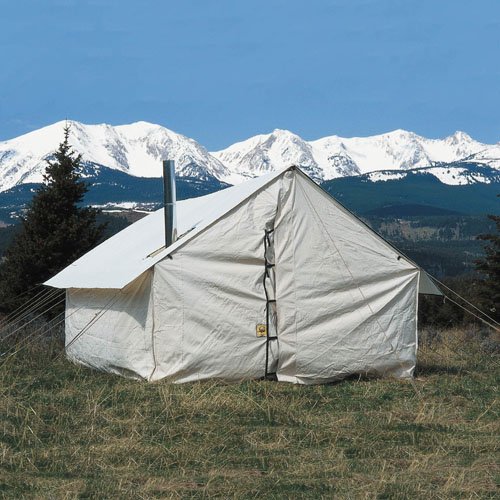
pic courtesy of http://www.outfitterssupply.com/
This tent pictured is a 10'x12' and weighs in at 65lbs, not including the aluminum poles(Some companies will make these same poles out of steel or even wood, which would add to the weight considerably. )and is made with 10oz cotton duck cloth, which is one of the lighter, less treated cloths.
- Cabela's - Kodiak Canvas Flex Bow Tent
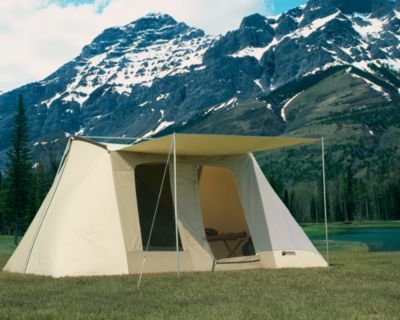
pic courtesy of http://www.cabelas.com/
This looks more like a typical big box store tent but is made of 8.5oz, treated, canvas duck cloth. It is a 10'x14', 8-person tent, that weighs in at 79lbs, not including it's galvanized steel tube poles.
- Cabela's - Range Tipi/Cowboy Tipi
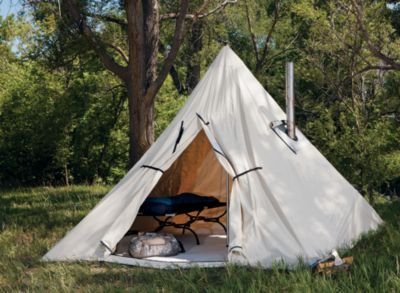
pic courtesy of cabelas.com
This particular tent is pretty versatile in its setup (2 ways to set it up and 3 if you get it from certain companies) and is 12'x12', made of 10oz cotton duck w an aluminum pole. This tent weighs in at 65lbs as well.
There are several varieties on shapes of canvas duck tents (also often called 'army duck' or 'marine army duck') , ranging from single persons shelters to 20+ person shelters. The cotton duck can be as light as 8oz and up to 12 or 16oz. Most are treated with a waterproofing agent and a fire retardant as well.
Let's look at the pros and cons of the canvas shelters.
Pros/Cons:
Pros
Cotton canvas is much more breathable than nylon tents so they tend to be less hot and stuffy in the warmer months and won't hold as much condensation on them, unless you have a double-wall or vented backpacker tent and then they may be comparable.
Cotton canvas tents are thicker so they don't tear as easily and patch easier if they do.
Canvas shelters seem to have more of a 'home' feel about them bc they are so thick, dense and sturdy feeling.
All these tents are able to be equipped with a stove jack, for heat/cooking.
All these tents have either floors already built in or can get them, w/ a cut-away for the stove.
Most of these are pretty straight-forward on the setup, but some of the larger ones may need instructions.
Most wall tents and similar ones stand up pretty good under high winds, inclement weather.
Cheaper than mountaineering/backpacking tents.
Cons
All the canvas tents are extremely heavy, in comparison to any other tent, whether big-box nylon or mountaineering/backpacking.
They must be treated with a lot of chemicals to keep them from breaking down fast, due to elements- either mold, mildew, rot or sun.
They tend to last many years before they do break down, IF treated.
They must be completely dried out and folded a specific way before packing, due to mold and packing restraints.
Depending on which one you bought, may need a pack animal for vehicle to carry it and/or the poles- not easily mobile.
Not able to have an open fire in them; only a stove IF fitted with a stove jack.
Pole system is heavy, space consuming and not very versatile, save the range tipi which can be tied to a tree w/out a pole.
If getting a larger shelter, you may need more in-depth instructions for setup, as there will be more pole parts, with the exception of the Cowboy Tipi (I just love the name of that one!).
Not sure the single pole setup of the Cowboy Tipi would stand well in inclement weather, being that it seems to not have as m any guy out points.
Price point is a bit high for the size you get, compared to nylon tents.
Hybrid/Happy-Middle Shelters
These are the shelters that bring some of the best of both worlds, of the above two categories, and sometimes not.
We will look at a few and see what they may have improved on, from the above two, and what they may leave to be desired.
- Tentipi
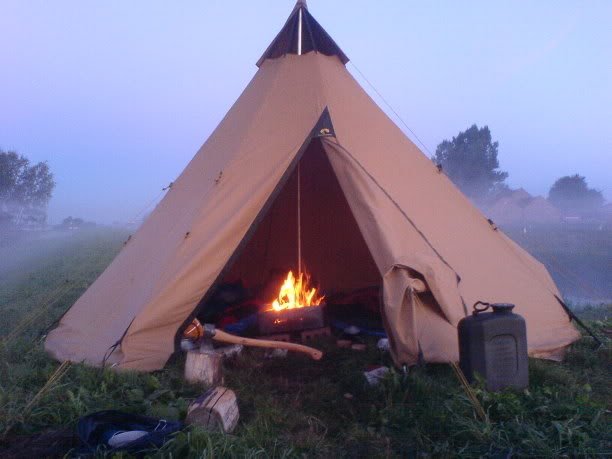
pic courtesy of https://tentipi.com
This company makes their tipis with a single-pole design & has a variety of fabric options, ranging from a more affordable cotton canvas version to a much lighter ripstop( called cotpolmex c), along with a middle grade fabric (called traillix). The lightest/smallest starts at 4lbs and goes up to a heavier 50lbs. You can see the choices for each tipi size also in fabric weight choices, which can be vastly different, depending on which fabric chosen (ex. a 15man tip in cotpolmex is 50lbs, but the same size tipi in taillix is only 15lbs). These tents are made to accommodate a stove, via a stovejack in the peak or an open fire (yes, you read that right). They also have many guy out points to withstand all types of inclement weather.
- Tipitent
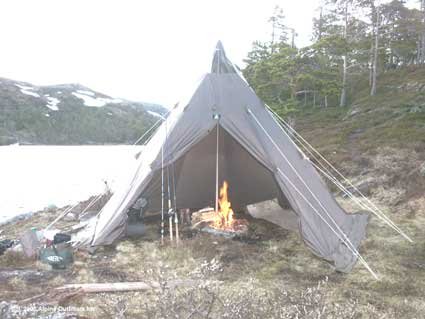
pic courtesy of http://www.tipitent.com
These tipis are made of of 185T rip-stop aluminum coated polyester, fire resistant with a waterproofing to 3000mm, w a 2-piece aluminum tent pole. They are designed with many guy out points for strength in inclement weather.
Weight range, for the 4-6man tipi, at 24lbs, including the pole, to the 10-12 man tipi at 35lbs. All their tents can accommodate a stove via a stovejack, either put through the peak or back of tipi, as well as an open fire (yup..another!).
Now, that we've looked at two 'hybrid' shelters, let's see how they measure up with the other two categories.
Pros/Cons:
Pros
These are much lighter than the canvas tents.
Has a single pole, making the load lighter and less complicated.
They allow for both stove AND open fires.
Enough guy out points to withstand just about any weather situation, next to a tornado, despite having a single pole.
Can have no floor or full floor with fire/stove cutout.
They pack down much smaller than a canvas tent.
Do not mildew or rot as easily as canvas.
Tentipi's cotpolmex fabric is breathable, similar to canvas duck.
Do not need a utility vehicle or pack animal to carry it or the pole.
One company's price point is about the same as canvas shelters.
Cons
One company's price point is much more than any of them; even more than Kifaru.
Not quite as breathable as canvas if you get the traillix fabric at tentipi.
Weighs much more than the backpacking shelters, which may cause quicker fatigue if carrying it.
Tipitent may tear easier, bc the fabric is closer to the backpacking fabrics.
Doesn't pack down as small as the backpacking shelters.
Conclusions
Now, that we've taken a pretty good look at a few of the shelters available, in the various types, compared the needed considerations for a journey such as the Greater Exodus, hopefully we can make a better informed choice on what to invest in for our families.
For us, our decision was first based on mobility only and price. Now that we have kids, we must factor that in and also have accounted for more 'living' space, as well. Each family is going to have things they need to consider, when looking at such a journey.
What is most important to your needs? How many people will be in your shelter? Are you accounting for all climates? Will you be able to carry it or split the load somehow?
One thing you may also not of considered is also if you don't have a shelter to pack. Do you know how to build a wilderness survival shelter? That is a whole different post, in addition to this one, but we've went long enough on packable ones for now. If you don't know how to build a shelter, we highly suggest at least youtubing how to build some and get out and practice if you can. Skills are always more valuable to have than actual products.
We truly hope this post has helped give you some ideas on what might work for you and what might not.
If YOU have some ideas too, we'd love to hear about them! Post it below!
If you would like to hear more about the Greater Exodus, if you've never heard of it,etc, feel free to check out vids from New2Torah on the subject (he has 3 of them) as well as Monte Judah , Rob Skiba and others. Here's some links to get you going.
Nice blog!
We are looking for a long term tent that will travel well...
shalom!
@jeejee
Hopefully, this helped you in that search.
Very in-depth great work!
Thanks! Hope we helped folks with it.
I love this! Definitely following this series to see how we should prepare.
So happy you like it and are following for more. Feel free to join the fb group as well, to swap ideas with others prepping for the same.